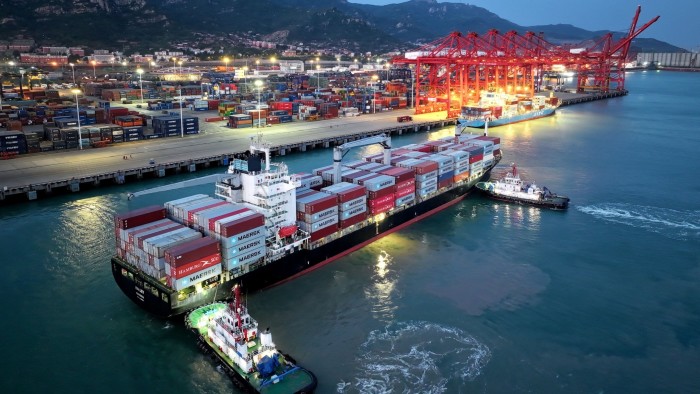Unlock the White House Watch newsletter for free
Your guide to what Trump’s second term means for Washington, business and the world
Container ships are some of the biggest and heaviest vessels on the sea. But piloting a container shipping line recently has been akin to being on a fishing boat in the roughest of weather.
The squalls have included US President Donald Trump’s on-off tariffs, port congestion, the Israel-Iran war, and the Houthi rebels in Yemen threatening to close off the Red Sea, not to mention the lasting effects of the disruption caused by Covid-19.
Simon Heaney, senior manager for container research at maritime consultancy Drewry, says: “Supply chains are meant to be boring and predictable.”
The latest deadline for Trump’s tariffs falls on July 9 but few in the container shipping industry — which serves as a proxy for both trade and globalisation due to the sheer volume of goods carried by ocean — believe it will be the final word.
One senior container shipping executive says the uncertainty around tariffs is making it difficult for customers. “They are going to order as much as possible now because they just don’t know what will happen in the rest of the year. It’s injecting a whole extra layer of complexity in supply chains.”
Both freight rates and share prices of listed container lines such as Denmark’s AP Møller-Maersk and Germany’s Hapag-Lloyd have been on a similar rollercoaster ride in recent months and years as fears of too much supply or demand have ebbed and flowed.
But now questions are being raised about whether the industry has become too reliant on shocks to keep it profitable, storing up problems for when conditions eventually normalise. Lurking in the background is a more philosophical question — how does an industry that built and benefits from globalisation survive when its main cheerleader turns on it?
Container shipping lines enjoyed extraordinary profits in the aftermath of the first wave of Covid. Drewry calculated that from 2020 until 2022, the industry made more money than in its previous 60 years combined. Much of that was ploughed back into buying new ships, particularly by the industry’s new number one player, Mediterranean Shipping Company.
Regular warnings of impending oversupply have surfaced ever since, but events have kept conspiring to put off judgment day. Heaney says a record amount of capacity in terms of containers is currently on order — about 30 per cent of the current active fleet — but that lines are not generally getting rid of their “clunkers” when new vessels arrive.
“The order book is a massive risk for the industry. They seem to be relying on the fact that there’s constant disruption. If and when the market normalises, they will be in massive trouble. They will have way too much capacity on their hands,” he adds.
Some in the shipping industry may be banking on Trump causing more disruption. After his first term, many companies responded to the threat of a trade war with China by diversifying their supply chains into south-east Asian countries such as Vietnam, Cambodia and Thailand. But this could be hit by the president’s swingeing tariffs. “It’s hard to make any big supply chain decisions just now,” explains one of Europe’s largest manufacturers.
Heaney says of the current mood: “There’s a level of exhaustion or fatigue over tariffs. There’s no sense of permanence to any decision. We’ve been strung along from one pause to another.”
Equally, however, shipping bosses feel somewhat protected from Trump’s broader assault on globalisation and his desire to bring back manufacturing to the US by just how entrenched many supply chains are. Vincent Clerc, Maersk’s chief executive, told the Financial Times in May that it would take Trump “a decade or two of persistent effort” to redraw global trade routes.
Many also believe that China and India will power a new era of globalisation. “It could be globalisation 2.0, at the same time as we are de-risking globalisation 1.0,” says the container executive.
For now, despite all the disruption and the criticism of container shipping lines for elevated freight rates and profitability, there are signs of the system working. Rates between China and the US are falling at record pace after lines upped capacity in the wake of surging demand sparked by Trump’s so-called liberation day. “It’s a good sign that the industry is reactive, that there’s competition,” says Heaney.
Still, other potentially bigger problems loom. Container shipping is likely to keep sailing on stormy seas for some time.
